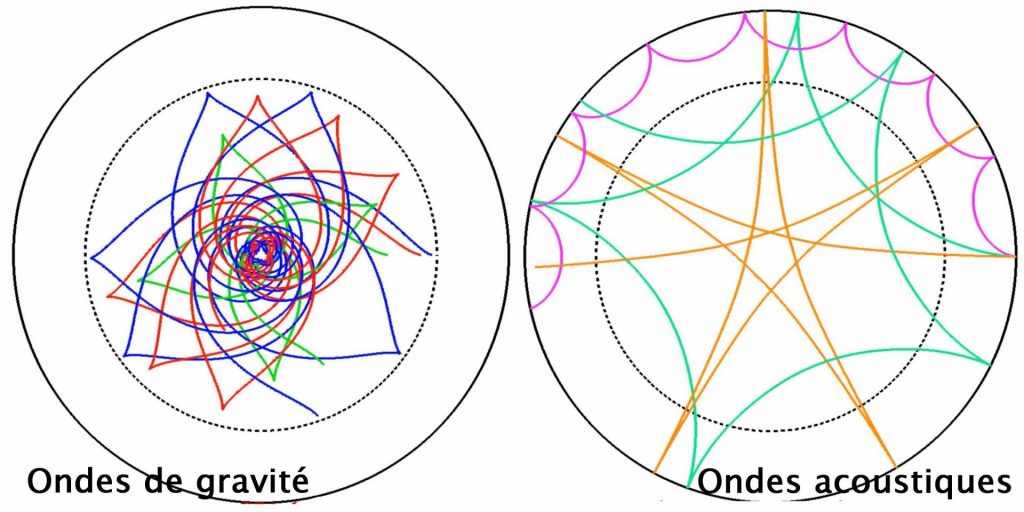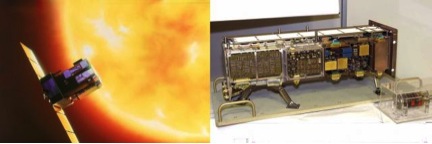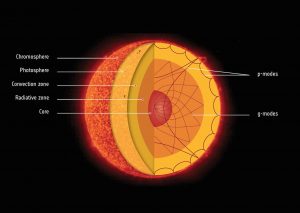The study of solar vibrations reveals the astonishing behavior of the thermonuclear center of the Sun
By analyzing more than 16 years of data collected by the GOLF instrument onboard the SOHO satellite, an international collaboration involving two researchers from the Department of Astrophysics-Laboratory AIM of CEA-IRFU has demonstrated a rapid rotation of heart of the sun. For the first time, researchers were able to indirectly determine the properties of solar gravity waves, oscillations affecting the innermost layers of the star. They were able to show that the Sun centre turns on average in a little more than 7 days, about 4 times faster than its surface. This rapid rotation could have been inherited from the first moments of the sun formation. These results are published in the Astronomy & Astrophysics journal of June 2017.

A fast rotating heart
Two types of waves propagate in the Sun. Acoustic waves are generated by pressure fluctuations induced by surface granulation. Gravity waves are governed by the Archimedes thrust. The gravity modes carry the physical properties of the deepest solar layers but have a very low amplitude at the surface of the Sun. Their detection has been discussed at length over the past 20 years and so far only ambiguous indications of their existence have been provided.

Today, researchers have been able to confirm the detection of their signature by looking “elsewhere and otherwise”. The signature of the gravity modes was found not directly by the detection of their surface signal but in the modulation of the travel time (about 4 hours 7 minutes) spent by the acoustic waves to make the round trip across the diameter by passing through the center. Thanks to continuous measurements by the GOLF instrument for more than 16 years, the average rotation rate of the thermonuclear core of the Sun has been measured accurately. It turns on itself in roughly a week, 3.8 times faster than the average rotation of the outer layers of the Sun which is 27 days (varying from 25 days at the equator to 35 days at the poles.). This measure confirms an estimate obtained in 2007 that evaluated that the heart rotated between 3 and 5 times faster. These results bring new constraints on the star evolution models and the transport of the angular moment from the early stages of the formation of the Sun and the Solar system. This rapid rotation is most probably inherited from the first moments of the Sun formation.
The unmatched success of the GOLF instrument
The Global Oscillations and Low Frequencies (GOLF) instrument launched in 1995 on board the SoHO (Solar and Heliospheric Observatory) satellite is a French-Spanish heliosismology experiment that measures the Sun's oscillation modes by observing the star globally . This resonance spectrometer measures the Doppler velocity between the satellite and the Sun in the sodium absorption line. This instrument aims to test the theoretical models of the Sun by introducing dynamic phenomena. The measurements collected by GOLF for more than 20 years to date constitute a unique and unparalleled database for the study of the interior of the Sun but also its magnetism. With the recent extension of the mission, the researchers hope to obtain 22 years of data corresponding to the continuous observation of the Sun during 2 complete solar cycles. This success is the result of the constant financial commitment of the European space agency ESA, American NASA, and French CNES.

Contacts: David Salabert, Sylvaine Turck-Chièze
Publication:
“Asymptotic g modes: Evidence for a rapid rotation of the solar core“,
Fossat, E., Boumier, P., Corbard, T., Provost, J., Salabert, D., Schmider, FX, Gabriel, AH, G., Renaud, C., Robillot, JM, Roca-Cortes , T., Turck-Chieze, S., Ulrich, RK
Published in Astronomy & Astrophysics, Volume XX, June 2017
See also : the ESA press release (1 August 2017)
the Côte d'Azur Observatory press release (1 August 2017)
the UCLA (University of California Los Angeles) press release (1 August 2017)
See also: – The oscillations of the Sun are reflected on the planet Neptune (February 16, 2017)
– Au coeur du Soleil (05 mai 2014, in French)
– Battements de coeur solaires (4 mai 2007, in French)
– Listening to the Sun: What is helioseismology? (in French)
– WHY SEISMOLOGY? (in French)
– News from the Laboratoire LDEE
Content : D. Salabert, J.M. Bonnet-Bidaud


